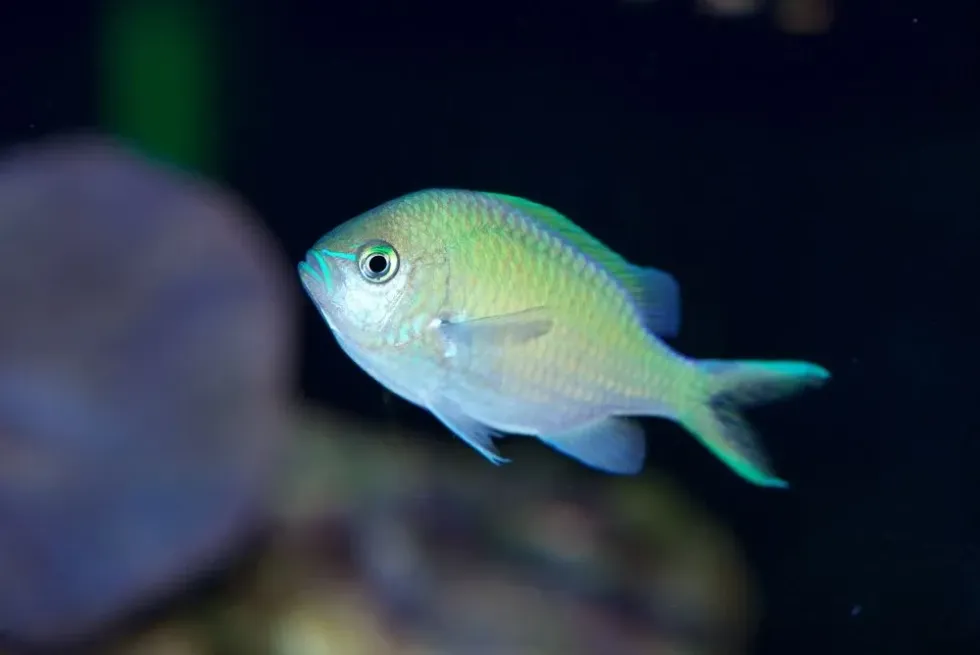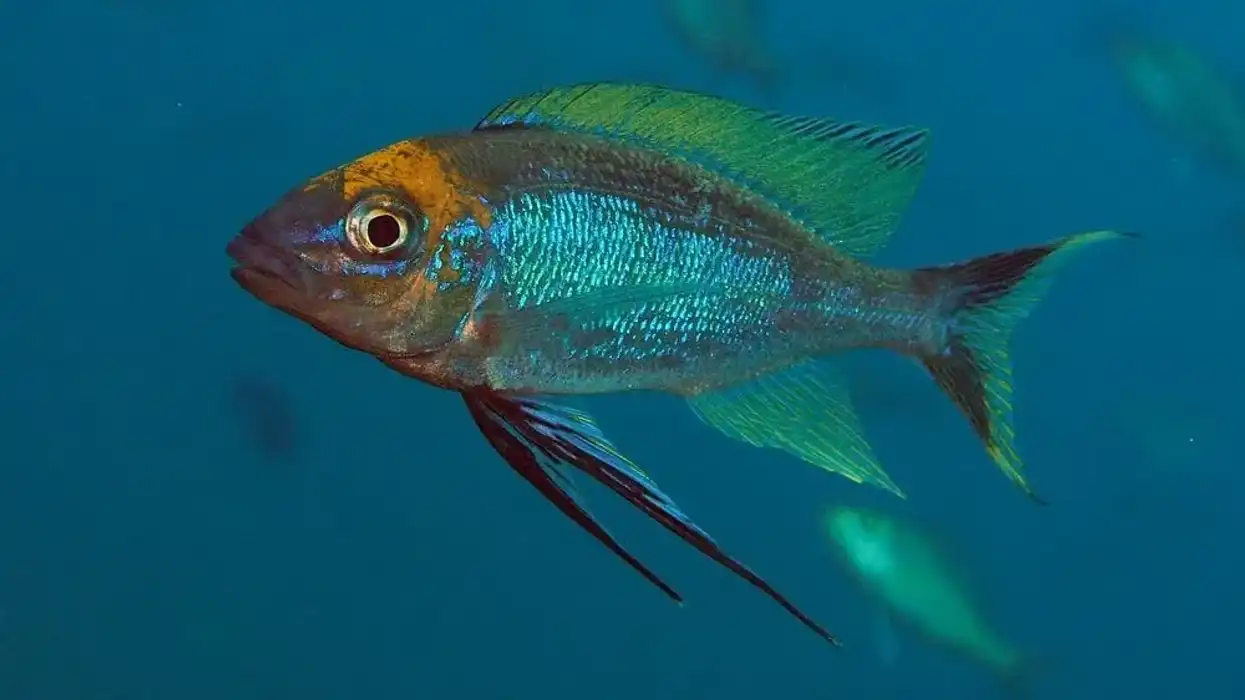The blue-green chromis fish species are a hardy, schooling fish known best for their exquisite pale bluish-green coloration. They are pretty small, rarely growing over 3-4 in (7.6-10.2 cm) on average.
They can be fascinating to watch in tanks as they are known for swimming in groups with synchronized movements. It can look like flashes of green floating around in the tank. They are also extremely social and do not fare well if kept alone.
These fish do need quite some space though, so a big tank of about 30 gal (136 l) in size is recommended. You should keep about six individuals in these circumstances as a smaller number could mean territorial battles.
Please keep reading on to learn more interesting facts about these animals. If you like reading about interesting animal facts, we suggest you check out our similar articles on African lungfish and lionfish.
Green Chromis Interesting Facts
What type of animal is a green Chromis?
Blue-green chromis, also known by their scientific name Chromis viridis, is a small saltwater fish species, known for its bluish-green coloration. They are known to be very active and can be quite mesmerizing to witness if you keep them as a shoal.
They tend to move through the decorations in the tank with synchronized movements and can be quite fascinating to watch.
They have social behavior which makes them amazing community fish and makes them compatible tank mates with both peaceful freshwater fish and saltwater fish. This hardy fish species needs big tanks decorated with reefs and corals.
What class of animal does a green Chromis belong to?
Blue-green chromis are a type of saltwater fish known for their terrific swimming qualities and exotic coloration. They are a pretty social and peaceful fish species which makes them excellent community fish and ideal pets for beginners.
How many green chromis are there in the world?
It is hard to say just how many blue-green chromis there are in the world as they are not enlisted on the IUCN Red List. It would be safe to assume that we have no reason to worry about their future as of now and that they are thriving in their natural habitat.
Where does a green chromis live?
These fish are known to live around the reef-structured regions in the Indo-Pacific Ocean. This is why they need a specific temperature in aquariums to feel comfortable.
What is a green Chromis's habitat?
These fish are known to school above reef structures in their wild habitats. Babies tend to live in rock structures until they are mature enough to join the school above.
Who does a green Chromis live with?
As a blue-green chromis is a peaceful and social fish, they are often found swimming around in the shallow coral reef structured range of the Indo-Pacific Ocean. These saltwater fish are known to live in a large school and are often found swimming in a large school.
If you want to keep them as pets, remember to place these fish in a saltwater aquarium or marine aquarium which is decorated with corals and reefs.
Blue-green chromis are very peaceful and social fish which makes them a great choice for a community aquarium.
As they are used to living in a large school, they tend not to fare well if kept alone. If you are thinking of keeping them try to place a school of six fish in an aquarium.
How long does a green chromis live?
Blue-green chromis tend to have a lifespan of about eight to 15 years if taken care of properly. Thankfully caring for them is quite easy and as they are omnivores feeding them is also an easy task.
They will probably eat anything you give them whether it is live, dried, or even flake foods.
Blue-green Chromis care is a fairly easy routine to follow which makes them a favorite for many fish keepers.
They are also very beautiful to witness when they are swimming around the corals and reefs of their saltwater aquarium as a shoal. Blue-green chromis fish are pretty synchronized when they are swimming in a shoal and often look like a flash of green in your aquarium.
How do they reproduce?
The blue-green chromis species is known for breeding in captivity only if particular water conditions with specific gravity are met. The breeding process is quite interesting in itself too.
Males of this saltwater fish species are known to make a nest in the sand substrate of the aquarium where females lay their eggs. Males strangely turn yellow with a black tail during mating, while females turn noticeably plumper.
The eggs are known to hatch pretty fast and the ones that fail to hatch, males are known to eat them.
You can help this situation by making sure the water conditions are right, and by feeding them live food items like brine shrimp, Mysis shrimp, and worms. This will help their natural mating behavior to be amplified.
What is their conservation status?
Green Chromis are Not Evaluated on the IUCN Red List, so it would be safe to assume that these damselfish are thriving out there in the wild. Unlike most other members of the damselfish family who tend to get noticed for their aggressive nature, these fish are very social and peaceful.
They are amazing swimmers who are known for their jumping skills as well. This is why you should try to keep them in tanks that are at least 30 gal (136 l) in size.
Green Chromis Fun Facts
What does green Chromis look like?
The blue-green chromis is a hardy little saltwater fish species, known for its beautiful bluish pale green color. As they are shoaling fish, they tend to swim around the aquarium as a group which can look like a green flash in your aquarium.
Males are known for changing their colors during the mating season, going from their usual pale blue-green to pale yellow with a black tail.
They are the only peaceful fish species of the damselfish family and can make preferable tank mates for all kinds of peaceful saltwater fish and freshwater fish.
As they are wonderful swimmers and very active, they tend to need quite a bit of space. With a marine setting, the minimum tank size is 30 gal (136 l), and decorated with reefs and corals should make an ideal artificial habitat for these marine fish.

How cute are they?
These fish are extremely cute with their small bodies and exquisite pale bluish-green coloring. They are very active and it can be fascinating to watch them swimming around as a shoal in and out of reef structures.
How do they communicate?
These small creatures communicate through various body gestures and their color has also been noticed to change. They are very social and tend to interact quite well with others.
How big is a green Chromis?
These fish have a length of about 3-4 in (7.6-10.2 cm) on average which is about the same length as a blue poison dart frog.
How fast can a green chromis swim?
There is no way to say just how fast these fish can swim as measuring that would be quite a task. It can be assumed though that they are not extremely fast due to their small body size. They are however known to be active swimmers and seem to be always on the move.
How much does a green Chromis weigh?
It is hard to say just how much these fish weigh as it would be next to impossible to weigh a live fish out of water. As they are pretty small, it is assumed that they might weigh somewhere around the weight of a very small frog.
What are the male and female names of the species?
The chromis fish do not have gender-specific names for their male and female counterparts. Male fish are known just as male blue-green chromis fish, and similarly, female fish are known as female blue-green chromis fish.
What would you call a baby green Chromis?
As with the babies of small fish worldwide, the babies of green chromis are known as fry. The eggs hatch pretty fast and interestingly, unhatched eggs get eaten by adult male fish.
What do they eat?
The hardy blue-green chromis are omnivores and they eat almost everything. You can feed them anything from vegetables to meat, and they will be happy to feed on them as long as they fit their mouths.
They prefer brine shrimps, mysis shrimps, worms, and other live food items, but they have been known to feed on algae as well.
These members of the damselfish species have also been known to feed on their eggs if they are left unhatched or nonfertilized. This is one of the reasons why they make excellent pets for beginners.
The blue-green chromis are not fussy about their food as long as they are content in their tanks.
Another thing you have to keep in mind is not to place them in tanks with larger or aggressive fish as there is a chance that these damselfish might get eaten by them. They are also coral and reef safe, so a good way to put them at ease would be to decorate the aquarium appropriately.
Are they dangerous?
The blue-green chromis, also known by their scientific name Chromis viridis, are the only members of the damselfish community who are not known to be aggressive. If you keep them with larger, aggressive fish there is a high chance that they will not survive and be mistaken for food.
You have to keep in mind though that these fish need quite a lot of space to swim around and explore, otherwise, mild dominance battles might break out between them if they become territorial.
A good way to prevent this from happening would be to place a group of at least six blue-green chromis together. As they are shoaling fish they tend fair well under these circumstances.
Would they make a good pet?
The blue-green chromis fish make amazing pets for all kinds of fish keepers as they are very low maintenance, active, and quite inexpensive to purchase. They are also omnivores which makes feeding them quite easy.
The only thing you have to keep in mind is to provide them with the correct temperature and tank size and they will be happy to just swim around.
The blue-green chromis are fascinating to watch as they tend to swim as a group which can look like flashes of green floating around in your tank. Do remember not to put them with aggressive and predatory fish as they might end up becoming fodder for them.
They prefer a marine setting in their aquariums as they are saltwater fish. They are also completely coral and reef safe, so a good way to provide them comfort would be to decorate their tanks with them. This way you will also get to enjoy them swimming around the reef structures, which can be a fascinating sight.
Did you know...
Interestingly, males are known for changing their colors from their usual pale green to pale yellow during the mating season.
Are chromis schooling fish?
The blue-green chromis are schooling fish and tend to swim around together as a school with synchronized movements. These damselfish are very fascinating to watch because of their beautiful coloration and active behavior. They are one of the busy fish types that seem to be always on the move.
How many green Chromis should I keep?
As these fish are schooling fish they do not tend to fare well if kept alone. These fish should be kept in a group of at least six individuals, as a small number have a high chance of territorial fights breaking out.
Here at Kidadl, we have carefully created lots of interesting family-friendly animal facts for everyone to discover! Learn more about some other fish including sandbar shark, or marlin.
You can even occupy yourself at home by drawing one on our green Chromis coloring pages.










